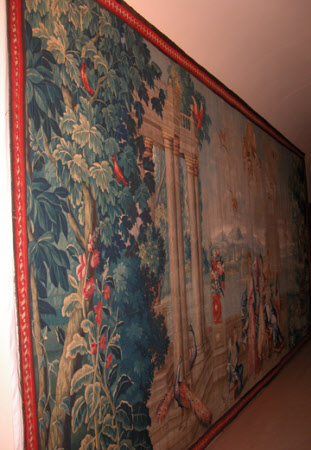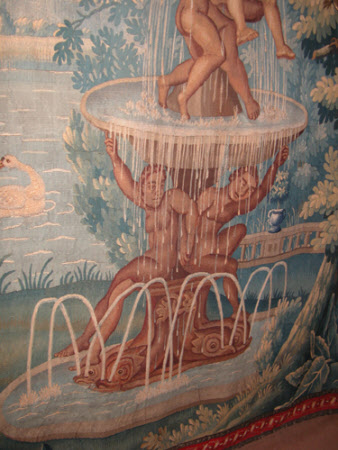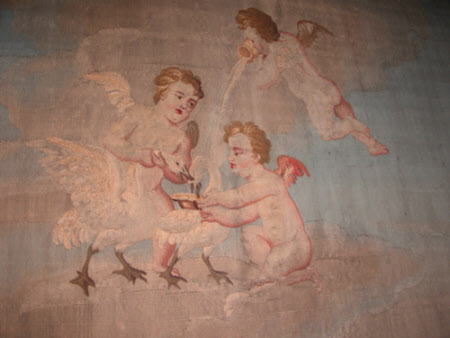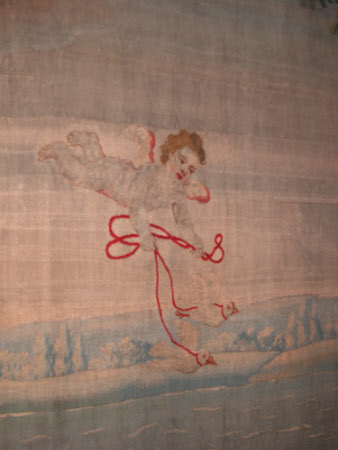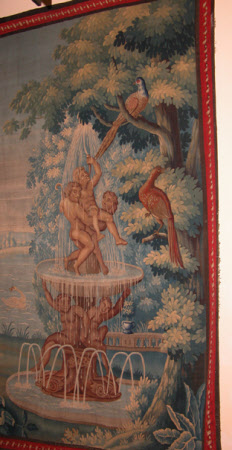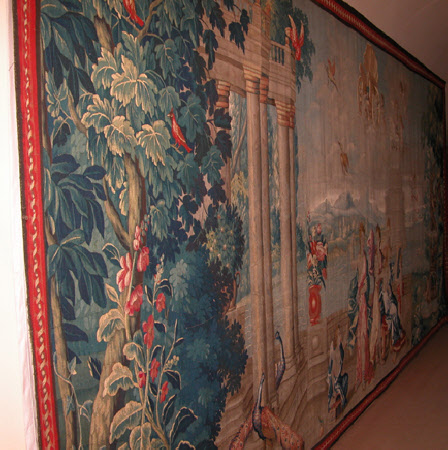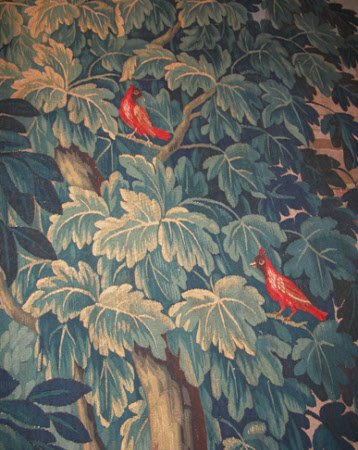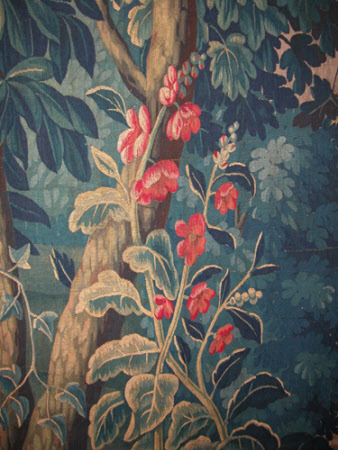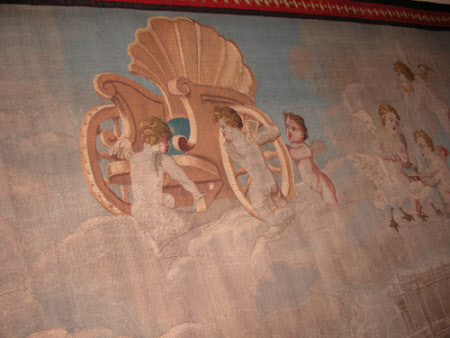The Toilet of Venus
John Vanderbank the elder (fl. 1682 - d. 1717)
Category
Tapestries
Date
circa 1695 - circa 1717
Materials
Tapestry, wool and silk, 6½ warps per cm
Measurements
244 x 164 cm
Place of origin
London
Order this imageCollection
Anglesey Abbey, Cambridgeshire
NT 516786
Summary
Tapestry, wool and silk, 6½ warps per cm, The Toilet of Venus from a set of two of the Story of Venus, John Vanderbank, London, after a design by Francesco Albani, c. 1695-1717. In the centre foreground Venus is seated on a stone balcony surrounded by nymphs with a winged cupid holding up a mirror for her to look into and another handing her jewels from a casket. On the left there is a large stone portico and beyond this foliage and flowers. Two peacocks and a red parrot perch on the portico. Behind Venus is a stretch of water with a large classical building on the other side. In the clouds above the figures a group of winged cupids guards Venus's chariot while others offer water to the swans that draw the chariot. Another cupid holds the reins of two white doves pulling him along in the sky, and in the water below are two more swans. On the right hand side of the tapestry is a landscape with two pheasants perched in the branches of trees and a fountain carved with nude boys. The tapestry has narrow borders with a running guilloche pattern in red and gold. Around a foot of the main field has been folded up at the back of the tapestry.
Full description
'The Toilet of Venus' and its companion, 'Venus and Vulcan', form part of a larger series of four tapestries that are ultimately based on paintings by Francesco Albani (1578-1660). Albani was commissioned to paint a set of frescoes for the Villa Favorita in Mantua by Ferdinando Gonzaga, Duke of Mantua in 1621. Only the cartoons had been executed when Ferdinando died in 1626, and Albani subsequently used these as the basis for a series of four paintings which he completed for another patron, Prince Gian Carlo de'Medici, in 1633. The paintings were acquired by the French State in 1684 and are now in the Louvre (Puglini 1999, pp. 156-7). The subjects of the four paintings are 'Venus at Vulcan's Forge', the 'Toilet of Venus', 'Venus and Adonis' and 'Diana's Nymphs Disarming Sleeping Cupids'. The theme of the series is the struggle between sacred and profane love, represented by Diana and Venus respectively, but the paintings may also have been intended as allegories of the four elements (Loire 1996, p. 61). The 'Story of Venus' tapestries were woven in London in the late seventeenth or early eighteenth century and may have been based on prints after Albani's paintings. The paintings were engraved in 1672 by Étienne Baudet, and again in the early eighteenth century by Benoît Audran. Alternatively, the tapestries could be based on another tapestry series woven in Brussels by Jan Frans van den Hecke (fl. 1660 – d. after 1700) and Judocus de Vos (1661-1734) (Brosens 2010). The Brussels tapestries are of a far higher quality than those produced by Vanderbank, as demonstrated by a set commissioned by Sir Robert Walpole in the 1720s that survives in State Bedroom at Houghton Hall, Norfolk. Vanderbank's tapestries depart from Albani's original paintings in a number of respects. There are added elements such as the parrots that perch in the trees in both tapestries at Anglesey Abbey, and other parts are omitted, for example a figure of Apollo in the sky in 'The Toilet of Venus'. Some of the added details, such as the parrots, also appear in the Brussels tapestries of the same subjects, suggesting that these were the source for Vanderbank's designs. Interestingly the 'Toilet of Venus' tapestry is in the same direction as the original painting, whereas 'Venus at Vulcan's Forge' is reversed. The two tapestries at Anglesey Abbey were almost certainly woven in London at the workshop of John Vanderbank (fl. 1682 – d. 1717). Vanderbank was a French protestant who had worked in Paris before being appointed Yeoman Arrasworker to William and Mary in 1689 (Thomson 1973, p. 361). Vanderbank's workshop was at his house in Great Queen Street, Holborn from at least 1698 (Sheppard 1966). A set of the 'Story of Venus' at Burghley House, Stamford, was signed 'JOHN VANDERBANK FECIT IN GREAT QUEEN STREET', and numerous other whole or partial sets have been identified by Marillier (Marillier 1929; Marillier 1930, pp. 115-22). These include a set installed at Holkham Hall, Norfolk in the 1750s with additional overdoors woven by George Smith Bradshaw. Another set signed by Vanderbank was in the collection of Mrs Harrison Williams, New York in 1929 (Sachs 1929). The tapestries at Anglesey Abbey probably date from between c. 1700 and 1717 when Vanderbank died. However after Vanderbank's death his wife Sarah continued to manage his workshop and draw his Wardrobe salary for another ten years until 1727, and then Vanderbank's son Moses took over, finally handing the workshop over to John Ellis in 1731. It is therefore possible that the tapestries were woven as late as 1731, although on stylistic grounds this is unlikely. The 'Story of Venus' designs enjoyed great popularity in the late seventeenth and eighteenth centuries, especially in England and France (Puglini 1996, pp. 60-67). Copies of Albani's paintings appear in many eighteenth-century English collections, including that of the Earl of Leicester at Holkham Hall, also home to a set of tapestries by Vanderbank. Mezzotints with details from the paintings taken from Baudet's engravings were published in London by John Smith (1652 – 1743) and William Beckett (fl. c. 1689 – 1704) in the early eighteenth century. The images were also used in other decorative media, for example a series of terracotta roundels made by Pierre-Etienne Monnot in 1693 (Loire 1996, p. 66). The date at which the two Anglesey Abbey tapestries were purchased for the house is unknown. They may be identical with two tapestries of the same subjects mentioned by Marillier as at Shardeloes, Buckinghamshire in 1929. Marillier published a photograph of the 'Toilet of Venus' which appears to be identical to the panel at Anglesey Abbey except that there is an additional section of foreground around a foot deep at the bottom. The corresponding section has been folded under at the bottom of the Anglesey Abbey tapestry to fit the low wall of the Library Corridor, which it fills exactly. (Helen Wyld, 2011)
Provenance
Bequeathed to the National Trust by Huttleston Rogers Broughton, 1st Lord Fairhaven (1896-1966) with the house and the rest of the contents.
Credit line
Anglesey Abbey, The Fairhaven Collection (The National Trust)
Makers and roles
John Vanderbank the elder (fl. 1682 - d. 1717), maker Francesco Albani (Bologna 1578 - Bologna 1660), designer
References
Brosens, 2002: Koenraad Brosens, 'Brussels Tapestry Producer Judocus de Vos (1661/62-1734) - New Data and Design Attributions', Studies in the Decorative Arts, Vol. IX, no. 2 (Spring/Summer 2002) Puglisi 1999 Catherine R. Puglisi, Francesco Albani, New Haven & London, 1999 Loire, 1996: Stéphane Loire, École italienne, XVIIe siècle, 1: Bologne, Paris, 1996 Thomson, 1973: W G Thomson, A History of Tapestry from the Earliest Times until the Present Day, 3rd edition, Wakefield 1973 Sheppard, 1966: 'Appendix I: The Soho Tapestry Makers', in F H W Sheppard (General editor), Survey of London: vols. XXXIV-XXXV, The Parish of St Anne Soho, London 1966, pp. 515-520 Marillier, 1930: Henry C Marillier, English Tapestries of the Eighteenth Century, London 1930 Marillier, 1929: Henry C Marillier, 'The Venus and Adonis Tapestries after Albani', The Burlington Magazine for Connoisseurs, vol. 54, no. 315 (June 1929), pp. 314, 318-21, 324 Sachs, 1929: Eleanor B Sachs, 'A Set of English Eighteenth Century Tapestries', Bulletin of the Needle and Bobbin Club, vol. 13 (1929), pp. 32-41
